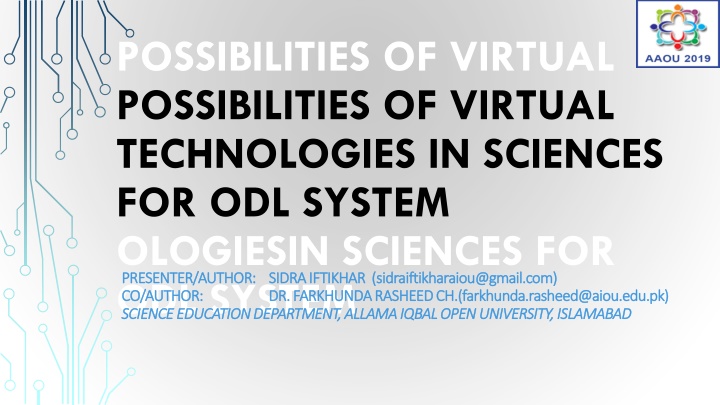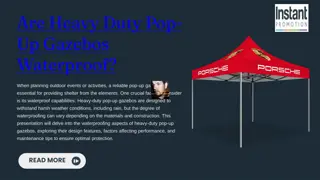
Enhancing Science Education Through Virtual Technologies in ODL System
Explore the possibilities of utilizing virtual technologies in science education for Open Distance Learning (ODL) systems. Virtual reality and augmented reality technologies offer immersive experiences, bridging the gap between physical and conceptual learning, enhancing retention, motivation, and creativity for learners in ODL systems.
Download Presentation

Please find below an Image/Link to download the presentation.
The content on the website is provided AS IS for your information and personal use only. It may not be sold, licensed, or shared on other websites without obtaining consent from the author. If you encounter any issues during the download, it is possible that the publisher has removed the file from their server.
You are allowed to download the files provided on this website for personal or commercial use, subject to the condition that they are used lawfully. All files are the property of their respective owners.
The content on the website is provided AS IS for your information and personal use only. It may not be sold, licensed, or shared on other websites without obtaining consent from the author.
E N D
Presentation Transcript
POSSIBILITIES OF VIRTUAL POSSIBILITIES OF VIRTUAL TECHNOLOGIES IN SCIENCES FOR ODL SYSTEM OLOGIESIN SCIENCES FOR ODL SYSTEM SCIENCE EDUCATION DEPARTMENT, ALLAMA IQBAL OPEN UNIVERSITY, ISLAMABAD SCIENCE EDUCATION DEPARTMENT, ALLAMA IQBAL OPEN UNIVERSITY, ISLAMABAD PRESENTER/AUTHOR: SIDRA IFTIKHAR (sidraiftikharaiou@gmail.com) PRESENTER/AUTHOR: SIDRA IFTIKHAR (sidraiftikharaiou@gmail.com) CO/AUTHOR: DR. FARKHUNDA RASHEED CH.(farkhunda.rasheed@aiou.edu.pk) CO/AUTHOR: DR. FARKHUNDA RASHEED CH.(farkhunda.rasheed@aiou.edu.pk)
INTRODUCTION There are many genres of digital technologies and virtual technologies are amongst the latest one. Virtual technologies can be mainly classified into two broad categories, virtual reality and augmented reality technology. Virtual reality technologies are particularly characterized by high degrees of immersion and interaction with making the learner engaged by physically present in the non-physical world (Freina & Ott, 2015). Augmented reality technology that presents real-time view enhanced by synthetic objects (Carmigniani & Furht, 2011) with video display. It is highly interactive technology that combines real and virtual worlds and allows the user to view simultaneously real and virtual world.
RATIONALE OF THE STUDY Open Distance Learning is one of the needs of this reckless era and there are many challenges to teach Sciences through distance learning. The teaching of science subjects demands conceptual and experiential learning with the provision of experimentation. The virtual technologies can bridge the gap between the learners physical pace, which is characteristically present in ODL and the conceptual, experiential learning and experimenting required in teaching of Sciences. Virtual Technologies can be considered as the effective medium for minimizing distraction, enhances retention, improve spatial abilities, develop interest, increase motivation, triggers academic achievement, and build creativity of the learners.
STATEMENT OF THE PROBLEM Most of our teaching and learning of science subjects is auditory which has no scope of imagination. Imagination is the key to human progress Alison & Brookfield, 2014). Virtual technologies by providing visualization, physically engaged and immersive environment triggers the learning of sciences. By providing immense visualizing experience, virtual technologies can open new horizons for sciences particularly in ODL system.
CURRENT SCENARIO OF VIRTUAL TECHNOLOGIES Modern education demands digital competence particularly open distance learning which bears the traditional segregation between the learner and the learning facilitator. This physical segregation demands extraordinary level of digital competence. In developed countries, there is the full provisions of virtual technologies in education from last two decades. In the context of Pakistan, we are now starting teaching with animations (Fayyaz Ahmad Ranjha, Muhammad Khalid Mahmood, Intzar Hussain Butt, 2019). Pakistan is too far for implementing virtual technologies in education.
OBJECTIVES OF THE STUDY To find out the use of virtual technologies for sciences in ODL system.
RESEARCH QUESTIONS What kinds of virtual technologies are being used in education around the world. What are the possibilities of the use of virtual technologies for science teaching and learning in Pakistan.
LITERATURE REVIEW Title Country Types of Virtual tools Plug-in Cortona, VRML Findings Author/Year The use of Virtual Reality enables conducting experiments with the interactively knowledge, enhance students creativity, motivation, Adriana Soares Pereira, Sandra Dutra Piovesan (2012) Virtual Reality Applied in Distance Education Spain It is suitable for distance learning and promotes self-study and independent learning Chris Lytridis, Avgoustos Tsinakos, Ioannis Kazanidis, (2018) ARTutor An Augmented Reality Platform for Interactive Distance Learning ARTutor learning platform Greece Better understanding and mitigate the feeling of isolation present in ODL, satisfaction with learning experience. Mustufa H. Abidi, Abdulaziz M. El-Tamimi, Abdulrahman M. Al-Ahmari,(2012) Sylvester J. Akpan, Paulinus J. Etim, Udom, Stella Ogechi, (2016) Virtual Reality: Next Generation Tool For Distance Education Virtual Classroom Instruction and Academic Performance of Educational Technology Students in Distance Education, Enugu State VRML Saudi Arabia Use of virtual classroom influence the academic performance of the ODL learners Nigeria Virtual classroom instruction
LITERATURE REVIEW Author/Year Title Country Types of virtual tools Findings Higher order thinking skills Matt Bower,Cathie Howe, Neida McCredie, Austin Robinson and David Grover, (2014) Augmented Reality in education- cases, places, and potentials Australia Phones and tablet devices Motivation, situated learning, Inquiry based learning, cognitive effort, spatial ability. Hakon Swensen, (2016) Potential of Augmented Reality in Sciences Education A Literature Review Application of Virtual Reality Technology in Distance Learning Norway Mobile phone game based Useful distance learning full operational. A virtual-campus system based on VR technology multi-user China Xue-qin Chang, Dao-hua Zhang, Xin-xin Jin, (2016)
LITERATURE REVIEW Title Country Author/Year Virtual tools WVBS-ATS, Autodesk, VR4Max Findings Collaborative learning, situated learning, role playing, problem based learning, creative learning USA Investigating learners attitudes toward virtual reality learning environments:Based on a constructivist approach Hsiu-Mei Huang,Ulrich Rauch, Shu-Sheng Liaw, (2010) Augmented Versus Virtual Reality in Education:An Exploratory Study Examining Science Knowledge Retention When Using Augmented Reality/Virtual Reality Mobile Applications Smartphone based (Samsung S4 app) VR is more engaging and both technologies enhances knowledge retention of the learners. Michigan Kuo-Ting Huang, Christopher Ball, Jessica Francis, Rabindra Ratan, Josephine Boumis, Joseph Fordham, (2019) SEEING THE UNSEEN SPATIAL VISUALIZATION OF THE SOLAR SYSTEM WITH PHYSICAL PROTOTYPES AND Gunver Majgaard, Lasse Juul Larsen, Patricia Lyk, & Morten Lyk, (2017). Google cardboard Spatial learning Denmark
LITERATURE REVIEW Author/Year Title Country/City Types of Virtual tools VR simulations The ability of VR Findings South Carolina Kapil Chalil Madathil, Kristin Frady, Rebecca Hartley, Jeffrey Bertrand, Myrtede Alfred, Anand Gramopadhye, (2017). An Empirical Study Investigating the Effectiveness of Integrating Virtual Reality based Case Studies into an Online Asynchronous Learning Environment. to reduce costs, allow students to interact with unobservable phenomena, and to increase perceived learning outcomes, student engagement, and usability. VR 3-D Glasses Carlos Carbonell, Jose Saorin, (2018) Virtual Learning Environments to enhance Spatial Orientation Spatial skills training Spain VR, AR and PDF3D Martin-Gutierrez, Garcia-Dominguez, Roca-Gonzalez, Sanjuan-Hernan Perez, Mato-Carrodeguas, (2013). Comparative Analysis Between Training Tools in Spatial Skills for Engineering Graphic Students Based on VR, AR and PDF3D Technologies AR shows better spatial training outcome scores than others. Spain
LITERATURE REVIEW Author/Year Title Country/City Type of Virtual tools Findings A practical guide to developing virtual and augmented reality exercises for teaching structural biology Possible Application of Virtual Reality in Geography Teaching. Maria Jose, Garcia Bonete, Maja Jensen, Gergely Katona (2019). Sketchfab Android and iOS applications Deep Learning of Biology Sweden Ivan Stojsic, Andelija Ivkov Dzigurski, Olja Maricic , Ljubica Ivanovic Bibic , Smiljana Dukicin Vu kovic, (2016) Birgitte Lund Nielsen, Harald Brandt, Hakon Swensen, (2016). Google Expeditions used with Google Cardboards Sandbox AR system Expeditions and other VR apps for Google Cardboard can enhance geography education Serbia Augmented Reality in Science Education-Affordances for student learning. Bridging formal and informal learning, concrete science examples, presence and involvement. Denmark
LITERATURE REVIEW Author/Year Title Country/City Virtual Tools Findings Mobile devices Medical, Military, AR books, AR gaming, Skills training Steve Chi-Yin Yuen, Gallayanee Yaoyuneyong, Erik Johnson, (2011). Augmented Reality: An Overview and Five Directions of AR in Education Mississippi Android based devices Interest in Astronomy has developed. B Maleke, D Paseru, R Padang, (2017). Learning Application of Astronomy Based AR using Android Platform. Indonesia Mobile Devices and web based tools Motivation, Attention, Concentration, Satisfaction, Creativity, Retention, Phil Diegmann, Manuel Schmidt- Kraepelin, (2015) Benefits of Augmented Reality in Educational Environments-A systematic Literature Review Germany
DATA ANALYSIS After collecting the relevant literature, meta- analysis was done. The relevant literature was searched from different research journals.
FINDINGS Virtual Worlds enable conducting experiments with the interactively knowledge, enhance students creativity, motivation, and knowledge retention. It is suitable for distance learning and promotes self-study and independent learning. It gives better understanding and mitigate the feeling of isolation present in ODL, satisfaction with learning experience. Use of virtual classroom influence the academic performance of the ODL learners. It enhances higher order thinking skills of the learners.
FINDINGS CONT.. It improves spatial abilities of the learners. Situated learning, Inquiry based learning, cognitive effort has been improved. Collaborative learning, role playing, problem based learning, and creative learning of the students increases. Bridging formal and informal learning, provide presence and involvement.
CONCLUSION It was concluded that there were various tools using in the educational context around the world. It is concluded from the literature that virtual technologies can provide seamless learning experience but unfortunately it is not implementing in Pakistan. Having immense visualization capabilities and with flexibility of time and space, it should be used in the educational context of Pakistan particularly for the teaching and learning of sciences in ODL system.






















